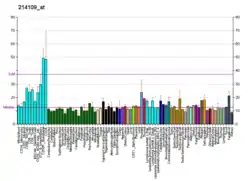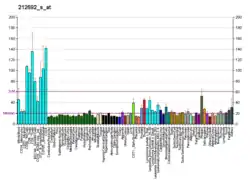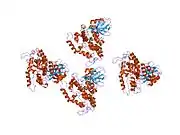LRBA
Lipopolysaccharide-responsive and beige-like anchor protein is a protein that in humans is encoded by the LRBA gene.[5][6][7]
| LRBA | |||||||||||||||||||||||||
|---|---|---|---|---|---|---|---|---|---|---|---|---|---|---|---|---|---|---|---|---|---|---|---|---|---|
 | |||||||||||||||||||||||||
| |||||||||||||||||||||||||
| Identifiers | |||||||||||||||||||||||||
| Aliases | LRBA, BGL, CDC4L, CVID8, LAB300, LBA, LPS responsive beige-like anchor protein | ||||||||||||||||||||||||
| External IDs | OMIM: 606453 MGI: 1933162 HomoloGene: 36205 GeneCards: LRBA | ||||||||||||||||||||||||
| |||||||||||||||||||||||||
| |||||||||||||||||||||||||
| |||||||||||||||||||||||||
| |||||||||||||||||||||||||
| Orthologs | |||||||||||||||||||||||||
| Species | Human | Mouse | |||||||||||||||||||||||
| Entrez | |||||||||||||||||||||||||
| Ensembl | |||||||||||||||||||||||||
| UniProt | |||||||||||||||||||||||||
| RefSeq (mRNA) | |||||||||||||||||||||||||
| RefSeq (protein) | |||||||||||||||||||||||||
| Location (UCSC) | Chr 4: 150.26 – 151.02 Mb | Chr 3: 86.22 – 86.78 Mb | |||||||||||||||||||||||
| PubMed search | [3] | [4] | |||||||||||||||||||||||
| Wikidata | |||||||||||||||||||||||||
| |||||||||||||||||||||||||
Patients with Chediak-Higashi syndrome (CHS1; MIM 214500) suffer from a systemic immunodeficiency involving defects in polarized trafficking of vesicles in a number of immune system cell types. In mouse, this syndrome is reproduced in strains with a mutation in the 'beige' gene that results in proteins lacking the BEACH (beige and CHS1) domain and C-terminal WD repeats. LRBA contains key features of both beige/CHS1 and A kinase anchor proteins (AKAPs; see MIM 602449).[supplied by OMIM][7]
Deficiency of this protein in humans causes the condition known as LPS-responsive beige-like anchor protein deficiency.
References
- GRCh38: Ensembl release 89: ENSG00000198589 - Ensembl, May 2017
- GRCm38: Ensembl release 89: ENSMUSG00000028080 - Ensembl, May 2017
- "Human PubMed Reference:". National Center for Biotechnology Information, U.S. National Library of Medicine.
- "Mouse PubMed Reference:". National Center for Biotechnology Information, U.S. National Library of Medicine.
- Feuchter AE, Freeman JD, Mager DL (Sep 1992). "Strategy for detecting cellular transcripts promoted by human endogenous long terminal repeats: identification of a novel gene (CDC4L) with homology to yeast CDC4". Genomics. 13 (4): 1237–46. doi:10.1016/0888-7543(92)90041-P. PMID 1505956.
- Wang JW, Howson J, Haller E, Kerr WG (Mar 2001). "Identification of a novel lipopolysaccharide-inducible gene with key features of both A kinase anchor proteins and chs1/beige proteins". J Immunol. 166 (7): 4586–95. doi:10.4049/jimmunol.166.7.4586. PMID 11254716.
- "Entrez Gene: LRBA LPS-responsive vesicle trafficking, beach and anchor containing".
Further reading
- Ewing RM, Chu P, Elisma F, et al. (2007). "Large-scale mapping of human protein–protein interactions by mass spectrometry". Mol. Syst. Biol. 3 (1): 89. doi:10.1038/msb4100134. PMC 1847948. PMID 17353931.
- Olsen JV, Blagoev B, Gnad F, et al. (2006). "Global, in vivo, and site-specific phosphorylation dynamics in signaling networks". Cell. 127 (3): 635–48. doi:10.1016/j.cell.2006.09.026. PMID 17081983. S2CID 7827573.
- Gebauer D, Li J, Jogl G, et al. (2005). "Crystal structure of the PH-BEACH domains of human LRBA/BGL". Biochemistry. 43 (47): 14873–80. doi:10.1021/bi049498y. PMID 15554694.
- Ota T, Suzuki Y, Nishikawa T, et al. (2004). "Complete sequencing and characterization of 21,243 full-length human cDNAs". Nat. Genet. 36 (1): 40–5. doi:10.1038/ng1285. PMID 14702039.
- Strausberg RL, Feingold EA, Grouse LH, et al. (2003). "Generation and initial analysis of more than 15,000 full-length human and mouse cDNA sequences". Proc. Natl. Acad. Sci. U.S.A. 99 (26): 16899–903. doi:10.1073/pnas.242603899. PMC 139241. PMID 12477932.
- Dyomin VG, Chaganti SR, Dyomina K, et al. (2003). "BCL8 is a novel, evolutionarily conserved human gene family encoding proteins with presumptive protein kinase A anchoring function". Genomics. 80 (2): 158–65. doi:10.1006/geno.2002.6822. PMID 12160729.
External links
- Overview of all the structural information available in the PDB for UniProt: P50851 (Lipopolysaccharide-responsive and beige-like anchor protein) at the PDBe-KB.
This article is issued from Wikipedia. The text is licensed under Creative Commons - Attribution - Sharealike. Additional terms may apply for the media files.






